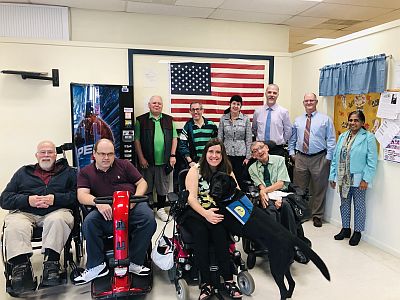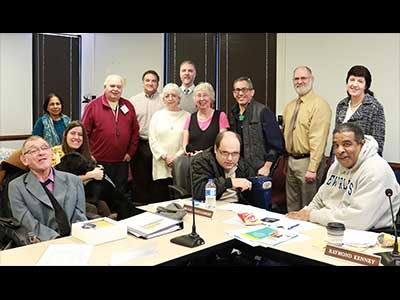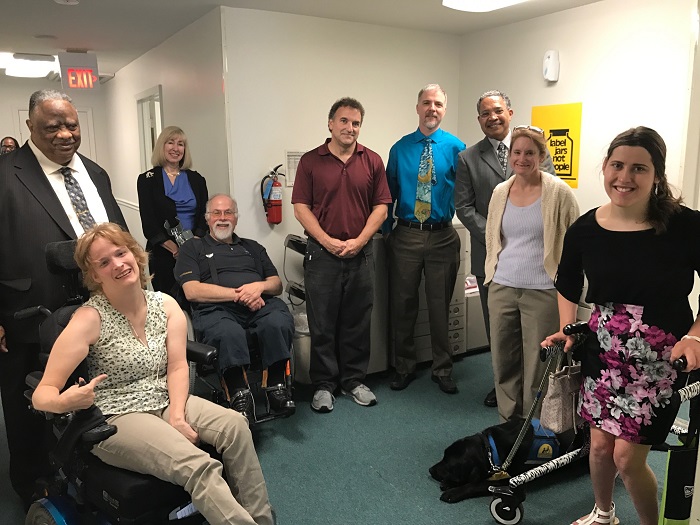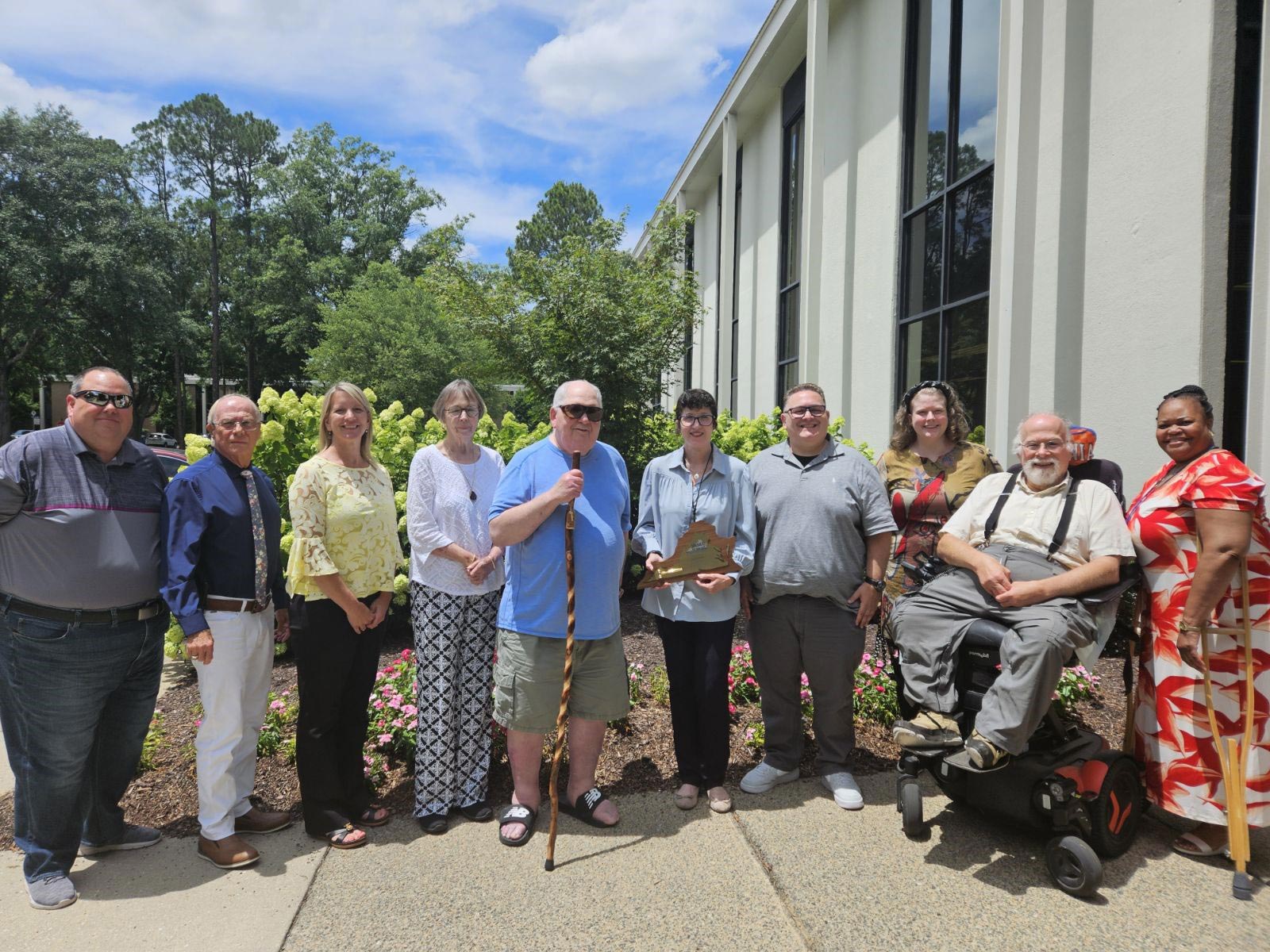Virginia State Plan for Independent Living — Years 2025 – 2027
Virginia Statewide Independent Living Council
Who We Are
The Statewide Independent Living Council (SILC) is an independent planning body working with the Centers for Independent Living (CILs) and Department for Aging and Rehabilitative Services to increase the impact of Independent Living (IL) services in Virginia. The SILC is composed of gubernatorial appointees who represent people with significant disabilities across the state, the interests of CILs, and Independent Living programs and services.
What We Do
We are responsible for the development and implementation of the Statewide Plan for Independent Living (SPIL). The SPIL, which is required by Section 704 of the federal Rehabilitation Act, is updated on a triennial basis and delineates specific objectives and timelines for ensuring that the Commonwealth is providing the appropriate planning, financial support and coordination, and other assistance to appropriately address the needs of citizen with disabilities for independent living services.
Vision
Virginia Statewide Independent Living Council: The Commonwealth's catalyst for inclusion of people with disabilities.
Mission
The Virginia Statewide Independent Living Council will promote policies, programs and activities to maximize independence of people with disabilities by:
- developing, monitoring, reviewing and evaluating the State Plan for Independent Living,
- supporting and expanding the state network of Centers for Independent Living,
- creating a culture for full integration and independence,
- advocating systems change for full access and equality in community life,
- educating policy makers and stakeholders about the importance of independent living,
- developing a strategy for collaboration among stakeholders in the disability community,
- leading to full inclusion and independence in the Commonwealth.
About SILC
Our Purpose
The purpose of the Statewide Independent Living Council is to develop a three year State Plan for Independent Living, facilitate the goals and activities within the Plan and distribute Rehabilitation Act Title VII, Part B funds allocated by Congress. The funds are distributed to Virginia through a Federal Formula Grant. The State Plan is revised every three years, but is continually monitored by the SILC. Public input into the planning efforts is welcomed at any time by contacting the SILC Administrator.
Our Members
One of the functions of the Office of the Secretary of the Commonwealth is to assist the Governor in his appointments of over 4,000 individuals to serve on Virginia's boards and commissions. That Office is deeply committed to the principle of including all segments of the Commonwealth's population into government, because this is what makes the theory of self-government a reality.
Individual member responsibilities include:
- Full understanding and embracement of the Independent Living philosophy
- Attendance at all assigned Council and Committee meetings, which are held at least quarterly and at various locations across Virginia. Some overnight travel is required.
- Knowledge of the Rehabilitation Act, specifically Title VII
- Understanding of funding streams for Council activities
- Understanding of Virginia's network of CILs and Designated State Entity (DSE)
If you wish to serve on the Statewide Independent Living Council, or recommend qualified candidates to serve, please visit https://www.commonwealth.virginia.gov/.
For a list of current vacancies or if you have any questions, please contact Lauren Snyder Roche, SILC Administrator.
Daniel Aranda, Vice Chairperson
Ida Barksdale
Garrett Brumfield
Gayl Brunk, Chairperson
Lauren Bryant
Nichole Davis
Christopher Grandle, Secretary
Harry Henderson, Treasurer
Sarah Liddle
David Minor
Gary Talley
Marcia DuBois
Virginia Department for Aging and Rehabilitative Services (DARS)
Richmond, Virginia
Eric Raff
Virginia Department for the Deaf and Hard of Hearing (VDDHH)
Richmond, Virginia
Lauren Snyder Roche
Virginia Department for Aging and Rehabilitative Services (DARS)
Richmond, Virginia
Facts About Centers for Independent Living (CILs) In Virginia
What is a Center for Independent Living?
Centers for Independent Living, often referred to as "CILs" are non-residential places of action and coalition, where persons with disabilities learn empowerment and develop the skills necessary to make lifestyle choices. Centers provide services and advocacy to promote the leadership, independence, and productivity of people with disabilities. Centers work with both individuals as well as with the local communities to remove barriers to independence and ensuring equality of persons with disabilities.
Who do Centers serve?
Centers provide services to individuals with disabilities as well as to the local community at large. Core services to individuals, provided by all Centers include Information and Referral, Peer Counseling, Independent Living Skills Training, Transition services, and Individual and Systems Change Advocacy. Services to the community include disability awareness, technical assistance regarding accessibility and legal issues, as well as general disability related information.
Where are Centers in Virginia?
The seventeen Centers for Independent Living are located in Norfolk, Hampton, the Eastern Shore, Richmond, Fredericksburg, Arlington, Manassas, Charlottesville, Winchester, Rocky Mount, Roanoke, Lynchburg, Abingdon, Grundy, Harrisonburg, Norton, and Christiansburg. There are three satellite Centers for Independent Living, in Petersburg, Ashburn, and Gloucester.
How are Centers for Independent Living funded?
Centers are non-profit organizations, which are funded by state, federal, local and private dollars. Part C of Title VII of the Federal Rehabilitation Act provides general operations money for CILs in Virginia in the amount of over $1.5 million dollars. Additional funds under Title VII, Part B of the Act are granted to Centers under the State Plan for Independent Living. The Plan, which is jointly developed and signed by the Statewide Independent Living Council, Center for Independent Living Executive Directors, and the Virginia Department for Aging and Rehabilitative Services, provides Part B funds to Centers for systems change activities. General fund dollars for Center operations and Youth Transition Services currently exceed $5 million dollars. A portion of the State General Fund dollars were used to expand Centers for Independent Living during the last five years. Centers also solicit local and private funding to meet service needs which have been identified at the local level.

How are Centers created?
Centers for Independent Living are created through the efforts of local people with disabilities, their family members, friends, and other interested persons. As people become organized, they begin to assess the local needs, level of local interest and support for a Center. Successful establishment of a Center for Independent Living often depends on networking, personal involvement, coalition building, and a commitment to the empowerment of persons with disabilities.
For additional information, contact Kevin Koziol, Director of Independent Living, at the Virginia Department for Aging and Rehabilitative Services (804) 662-7078 (Voice) or email: kevin.koziol@dars.virginia.gov
Meetings, Minutes, and other Documents
Below, you will find a downloadable list of all our meetings, current and the most recent year. Additionally, you can download copies of all minutes, organized by committee. There are also links for other SILC documents, such as our State Plan and Policies & Procedures Manaul.
You can move through the items using the previous and next buttons, or you can do a keyword search, which will search the full text of all of our downloadable documents.
SILC History
In 1992, Section 705 of the Federal Rehabilitation Act authorized the creation of the Statewide Independent Living Council. The act required each state to establish a SILC within one year of the date of enactment. Virginia's response to this federal law was enacted in 1994, as Part A of the legislation and resulted in the development of the first Virginia SILC. In 2006, Parts B and C were added to the state code further defining the SILC fiscal responsibilities under Virginia law.
Following the composition and term requirements outlined in the federal mandate, the gubernatorial appointees for the first SILC were assigned staggered terms beginning with the federal fiscal year October 1993 - September 1994. The composition requirements outlined in the initial act continues to direct the membership roster of the Virginia SILC. The mandate states that the membership shall remain at or above 51% of people who represent a broad range of significant disabilities and are knowledgeable about CILs and IL services.
Since 1995, the State Plan for Independent Living (SPIL) has been written by the SILC. As mandated in section 704 of the Rehabilitation Act, the SPIL is written in three year increments and delineates specific objectives and timelines for ensuring that the Commonwealth is providing the appropriate planning, financial support, coordination and other assistance to adequately address the IL service needs of the citizens with disabilities.
One of the priorities of the SILC has been program support and advocacy in the development of Centers for Independent Living (CILs) throughout the Commonwealth. Through the SPIL, programmatic funds have been made available to assist the current sixteen (16) CILs and the four (4) satellites to address IL advocacy needs. These community based CILs have afforded localities the opportunity to address the specific IL needs of an area and to develop an active advocacy coalition at the local and state level.
The SILC, the states' designated state units, which in Virginia are the Department of Rehabilitative Services (DRS) and the Department for the Blind and Vision Impaired (DBVI), the CILs and all parties affected by the IL philosophy, work together to formulate the focus for each SPIL. The following is an overview of Virginia's SPIL from its inception in 1995.
- The SILC supported (not by funding, but by actively advocating for) three additional CILs in Virginia
- The SILC began in establish their independence by making an “independent office” a goal
- Consumer coalition building was also a goal and the SILC began to understand that Part B funds could be used for other projects and not only direct services
- The SILC advocated for cost of living increases for CILs
- Outreach to racial and ethnic minorities was also a priority as data was gathered among CILs
- Some Part B funds were used to establish local coalitions, however the majority of funds were again granted to CILs for consumer goods and services
- The SILC began to support a “consumerism movement” and began to advocate for and provide information via the Internet, Action Alerts, supporting a statewide conference and supporting other training activities
- SILC began to see a need to develop local advocacy efforts in an orchestrated manner
- There was a shift in Part B funding from direct services to supporting the development of local consumer advocacy groups, training CIL consumers and staff and making a concentrated effort to support and advocate for more personal assistance services, nursing home transition activities, and other systems change activities
- Center in Fredericksburg was transitioned off of Part B funds
- The SILC also funded the CIRCLE Project (Creating and Implementing Responsiveness in Community Living to Endependence) which investigated Medicaid and Medicare Home and Community Based Services, looking at ways to “open up” those programs
- At the onset of this plan, the SILC began to focus its efforts on systems change activities rather than the funding of direct services
- The SILC funded the Community Action Specialist (CAS) project designed to continue building coalitions and consumer advocacy groups at the local level, training consumers, and advocating for both system-wide and local change.
- Through Part B funds the SILC provided funding for each CIL to hire a Community Action Specialist and actively work on establishing local consumer advocacy groups
- The SILC also focused on maintaining a visible Website and providing ongoing information to consumers, supporting additional funding for CILs and organizational change for the Council
- The SILC, again, focused on information sharing and informational access as a way to increase the knowledge base and advocacy efforts of consumers
- A goal was also set to improve and increase youth advocacy through youth leadership development and inclusion
- Systems change activities at the local and state level through the continued funding of the CAS Project with the majority of Part B funding coming into Virginia
- The importance of the SILC’s “autonomy and economic independence” remained both a priority and a goal
Additional accomplishments for the SILC during this period but not specifically required by the SPIL include:
- the development of a five year plan referred to in the SILC minutes as, SNAPSHOT
- the SILC partnered with the DSU to sponsor an advocates' meeting to celebrate the twenty year anniversary of the enactment of the Virginians with Disability Act
- the Warren G Stambaugh Foundation donated funds to the SILC which necessitated the development of the Statewide Independent Living Fund (SILF). This fund was established to allow the SILC to accept grants, gifts, donations and bequests on behalf of the Council from any source and to deposit all monies into the fund.
- The SILC worked with the network of the CILs and the DSUs to review and identify gaps in independent living services in geographic regions of Virginia not served by a CIL. A series of town hall forums were held in Planning Districts 9 (lower part), 13 and 14.
- The SILC worked in conjunction with the Office of Community Integration and various community partners to assist in implementing the initiatives identified Cross Governmental Strategic Plan.
- Part B Funds were awarded to the CILs in systems change advocacy, addressing the local level needs of individuals transitioning out of institutions in housing, transportation and personal assistance services.
- The SILC promoted the ongoing education and compliance with the Americans with Disabilities Act and other major disability rights laws.
Additional accomplishments during this period not specifically listed in the SPIL include:
- the credited participation of the SILC in the development of a manual currently used by Congress which establishes the necessary accessibility guidelines for assisting those individuals with disabilities
- Working with the Virginia Department of Housing and Community Development, the SILC investigated the feasibility of obtaining federal certification of the uniform statewide building code.
- The SILC worked with the network of the CILs and the DSUs to review and identify gaps in independent living services in geographic regions of Virginia not served by a CIL. A series of town hall forums were held in Planning Districts 9 (lower part), 13 and 14.
- The SILC worked in conjunction with the Office of Community Integration and various community partners to assist in implementing the initiatives identified Cross Governmental Strategic Plan.
- Part B Funds were awarded to the CILs in systems change advocacy, addressing the local level needs of individuals transitioning out of institutions in housing, transportation and personal assistance services.
- The SILC promoted the ongoing education and compliance with the Americans with Disabilities Act and other major disability rights laws.
Additional accomplishments during this period not specifically listed in the SPIL include:
- the credited participation of the SILC in the development of a manual currently used by Congress which establishes the necessary accessibility guidelines for assisting those individuals with disabilities
- Working with the Virginia Department of Housing and Community Development, the SILC investigated the feasibility of obtaining federal certification of the uniform statewide building code.
- The SILC awarded Part B funds to the disAbility Resource Center in Fredericksburg to provide guidance and mentoring to consumer groups in the lower part of Planning District 9, a geographically unserved area of Virginia. This area encompasses Culpeper, Madison, Orange and Rappahannock Counties.
- For a final SPIL cycle, Part B Funds were awarded to the sixteen CILs for systems change advocacy, addressing the local level needs of individuals in housing, transportation and personal assistance services including support service providers, to ensure a smooth transition into community or allow someone to remain in the community.
-
The SILC reviewed the accessibility of key state websites to ensure compliance with Title IV of the Telecommunications Act, and sought collaboration activity with state agency heads and webmasters, while advocating for equal access for individuals with disabilities.
Additional accomplishments during this period not specifically listed in the SPIL include:- The satellite office located in New River Valley (Southwest Virginia) converted to a full-fledged Center for Independent Living in Planning District 5, serving Allegany, Craig, Botetourt, and Roanoke Counties, and the city of Christiansburg
- The SILC was a sponsor of the 2015 IL Conference which included a celebration of the Virginians with Disabilities Act and the Americans with Disabilities Act (ADA). Approximately 260 individuals attended this event, including CIL staff, consumers, SILC members, service providers and Governor McAuliffe.
- Each year several current and former SILC members join the CIL network at the Virginia General Assembly for IL Day, to meet with their respective state legislators to advocate for funding support of the CILs and to educate them about the potential effects of legislative decisions on the lives of individuals with disabilities.
- SILC members regularly attend the Annual Conference on Independent Living in July of each year. The conference provided the opportunity for members to attend workshops, network with other IL advocates on a national level, march to the U.S. Capitol and shape the future of independent living.
The Virginia Statewide Independent Living Council has worked to help Centers for Independent Living implement the newest fifth Core Service, Transition, in the consecutive 2017 and 2021 State Plans for Independent Living (SPILs). The Centers did tremendous work to build out relationships that would support and enhance their capabilities to provide all 3 prongs of Transition services to as many consumers as possible. The below measurable outcomes speak to this work, as well as the systems change that has taken place over the years covered by these 2 State Plans for Independent Living.
Measurable Outcomes for 2018 -2024
Number of people with disabilities in nursing facilities the CIL had direct contact with: 1,863
Number of nursing facilities involved in CIL led outreach and training activities: 1,564
Number of hospital staff responsible for long term care screening involved in CIL led outreach and training activities: 713
Number of preadmission screening teams involved in CIL led outreach and training activities: 557
Number of high school students involved in CIL led outreach and training activities: 8,546
Number of youth who have left public education and not yet 25 years of age involved in CIL led outreach and training activities: 3,257
Number of public school, college, DARS and CSB staff involved in CIL led outreach and training activities: 12,139
Data Began to be Collected in FFY23 & 24 on:
Number of staff of institutional settings, other than nursing facilities, involved in CIL led outreach and training: 406
Number of people with disabilities in institutional settings, other than nursing facilities, the CIL had direct contact with: 300
Resources
The following list of agencies and organizations has been compiled by the Virginia SILC in an effort to help consumers easily locate resources that may be of assistance in their daily lives, and in achieving and maintaining Independent Living. By clicking on the links you are leaving the Virginia SILC website. Virginia SILC is not responsible for the content and privacy policies related to the site. All external links will open in a new tab or window.
Virginia Association of Personal Care Providers
Virginia Assistive Technology Loan Fund Authority (ATLFA)
Virginia Department for the Blind and Vision Impaired (DBVI)
Virginia Department for the Deaf and Hard of Hearing (VDDHH)
Virginia Department of Medical Assistance Services (DMAS)
Virginia Department of Behavioral Health and Development Services (DBHDS)
Independent Living (IL): A philosophy which includes consumer control, peer support, self-help, self-determination, equal access, and individual and systems advocacy. These qualities maximize the leadership, empowerment, independence, and productivity of individuals with disabilities. The optimal goal is the integration and full inclusion of individuals with disabilities into the mainstream of American society.
Statewide Independent Living Council (SILC): An independent planning body working with the Department of Rehabilitative Services, the Department for the Blind and Vision Impaired (DBVI) and the Centers for Independent Living (CILs) to increase the impact of independent living services in Virginia. The SILC is composed of gubernatorial appointees who represent people with significant disabilities from across the state, as well as, the interests of other independent living programs and services. The state qualifies for federal IL funds because of the existence of the SILC and the SILCs federal mandate to develop a three year State Plan for Independent Living (SPIL) which outlines IL priorities and identifies IL needs for the Commonwealth's citizens.
Centers For Independent Living (CILs): A non-residential place of action and coalition, where persons with disabilities learn empowerment and develop the skills necessary to make lifestyle choices. Centers provide services and advocacy to promote the leadership, independence and productivity of people with disabilities. Centers work with individuals, local communities, government agencies and the SILC to remove barriers to independence and to ensure equality of persons with disabilities.





